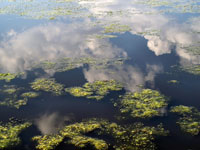Professor Shikha Nangia Named as the Milton and Ann Stevenson Endowed Professor of Biomedical and Chemical Engineering
The College of Engineering and Computer Science (ECS) has announced the appointment of Shikha Nangia as the Milton and Ann Stevenson Endowed Professor of Biomedical and Chemical Engineering. Made possible by a gift from the late Milton and Ann Stevenson,…


 Sureshkumar and Wani have discovered a method to make algae, which can be used in the production of biofuels, grow faster by manipulating light particles through the use of nanobiotechnology. By creating accelerated photosynthesis, algae will grow faster with minimal change in the ecological resources required. This method is highlighted in the August 2010 issue of Nature Magazine.
Sureshkumar and Wani have discovered a method to make algae, which can be used in the production of biofuels, grow faster by manipulating light particles through the use of nanobiotechnology. By creating accelerated photosynthesis, algae will grow faster with minimal change in the ecological resources required. This method is highlighted in the August 2010 issue of Nature Magazine.